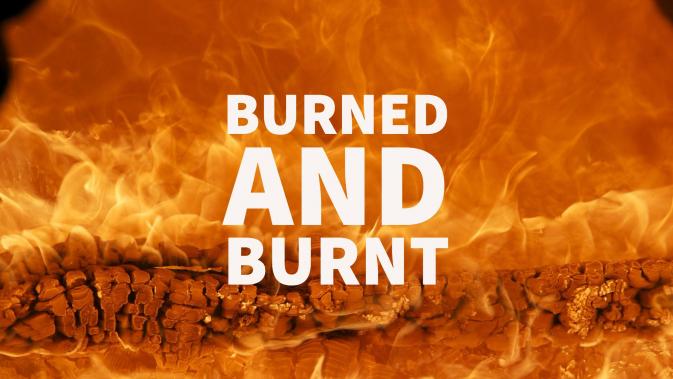I used to be a terrible cook. One problem was that I would get distracted and end up burning things a lot, but in such cases, should I say dinner is burned or should I say it’s burnt? Why do we have two forms of that word?
The Verb: ‘Burned’ Versus ‘Burnt’
Burned and burnt are both acceptable past-tense forms of the verb to burn, but which one you use depends on where you live because the verb burned is the much more common form in the United States and Canada. Burned and burnt are used more interchangeably as a verb in Britain, so I tend to think of burnt as a British form of the verb. For example, the Oxford English Dictionary, which takes a British approach given that it is published in Oxford, says that burnt as a verb is “always permissible,” but burned is “slightly archaic and somewhat more formal” than burnt. So, you might say
Mom burned the muffins. (US)
Mum burnt the crumpets. (UK)
Also, A Dictionary of Modern English Usage says that the two forms can have slightly different meanings. For example, if you say a house burnt down, that implies it happened quickly, but people are more likely to use burned for something that took a long time, like the fire burned for days. But this isn’t a hard-and-fast rule.
Burned is the older form of the word, and we only have burnt because of a British trend toward adding -t instead of -ed to verbs that started in the sixteenth century. It’s the same reason we have the pairs learned and learnt, spilled and spilt, spelled and spelt and so on. (1)
Over the centuries, people on both sides of the pond sometimes liked burnt and sometimes didn’t, but the burnt form eventually stuck in Britain. Americans haven’t been so sure about it. Burnt was more popular than burned in America in most of the eighteenth century, but then burned overtook it again in the nineteenth century, (1) and that’s what we’re more likely to use today.
We roasted s’mores as the campfire burned.
As soon as a redwood is cut down or burned, it sends up a crowd of eager, hopeful shoots, which, if allowed to grow, would in a few decades attain a height of a hundred feet, and the strongest of them would finally become giants as great as the original tree. —John Muir.
The Adjective: ‘Burned’ Versus ‘Burnt’
But if we consider burned and burnt as adjectives, then the two words are on more equal footing in the US. In fact, you’re more likely to see burnt as an adjective than as a verb here.
For example, burnt is an adjective when you’re talking about burnt sienna, the color of a crayon—and apparently a beloved color because the Crayola company retired some colors in 2003, but let people vote on one to save. Burnt sienna was the winner, beating out blizzard blue, magic mint, mulberry, and teal blue, which are no more.
Burnt Sienna Is Actually Burned
And this is a fascinating aside: sienna is a type of dirt that contains ferric oxide, basically a component of iron, that’s used as a pigment, and it actually is burned—roasted—to make the reddish-brown color. It’s yellowish-brown if it isn’t roasted.
So burnt is an adjective because it’s describing the type of sienna.
I actually wonder how much the popularity of these crayon colors we play with as children has to do with our American acceptance of burnt as an adjective. Besides burnt sienna, we also have burnt umber (retired in 1944) and burnt orange (still in production).
‘Burnt’ the Adjective: Examples
Here are two more examples of burnt as an adjective:
My favorite dessert is burnt cream. and
The priest helped with burnt offerings.
That’s your Quick and Dirty Tip: Burned and burnt are both OK. If you’re in the United States, you’ll sound more natural if you stick with burned as the verb and save burnt to use as an adjective.
Additional Source
Anderwald, Lieselotte. Burned, Dwelled, Dre
amed: The Evolution of a Morphological Americanism and the Role of Prescriptive Grammar Writing. American Speech. (2014). 89(4), 408-40.




